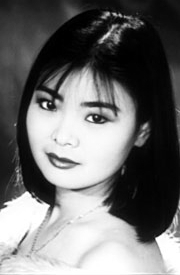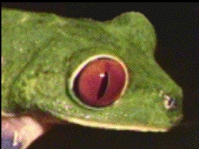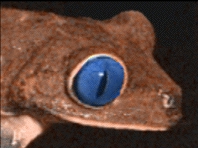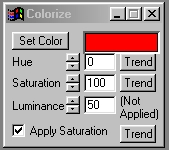| This is a child page. You can use Parent in the quick nav bar at the top or the bottom of the page to navigate directly back to the parent of this page. Some child pages are more than one level deep, and in that case will require more than one Parent click to reach the outermost document level. |
§ 16.100 - Colorize
| Quick Reference to Scripting Command |
| a=COLORIZE(hue, saturation, luma, APPLY SATURATION) [luma not applied] |
| Items in CAPS are 0/1 or ranges with more options than just 0/1. Ranges other than 0/1 are indicated by brackets, such as [0-2]. |

 Original image |
 Colorized |
 Original Image |
 Colorized |
§ 16.100.1 - Colorize Controls
§ 16.100.1.1 - Trends
Operator dialog controls that have a Trend button next to them offer animation functionality. Trend allows you to set that variable over a set of frames. Each frame of the animation can be thought of as a slice of time. The trends allow you to alter some, all, or none of the variables for a particular time slice. Variables that have multiple states can be set to any of a number of values in the trend. Variables that are either on or off can only have an on or off value in the trend. You will notice that the trend graphs have equidistantly spaced vertical lines. Each of these lines represents a frame in the animation. The number of frames can be altered using Sequence controls... in the TimeLine pull down menu. Animation lengths of 100 - 999 frames will be represented with a vertical bar being 10 frames, and animation length greater than 1000 frames will have a vertical bar for every 100 frames. Click here to view more information on Trends.
§ 16.100.1.2 - Hue
The Hue control allows you to adjust the Hue setting for the Colorize color. The selected Hue can be applied by itself or with the saturation value to create different effects. The Hue can range from 0 to 360 degrees, and is set using the slide gadget or by entering the appropriate value in the text entry area.
§ 16.100.1.3 - Saturation
This control allows you to adjust the amount of saturation in the Colorize color selection. The saturation value may or may not be applied to the selected area based on the setting of the Apply Saturation Also control. If this control is not selected, the saturation setting will have no effect. F/x will use the saturation value of the image in Colorizing the image. In order to see the Hue that's to be applied, you may want to increase the saturation. Doing this will cause the preview color to be closer to the color applied. The pictures below show an example of the difference between using and not using the saturation.
 Using Saturation |
 Not Using Saturation |
§ 16.100.1.4 - Luma
The Luminosity, how bright or dark a pixel is, is not used in this operation, but adjusting the luma can aid in visualizing the desired color.
§ 16.100.1.5 - Pick Color
This control will present the Color Selection controls. These controls can be used to specify the color to be used for colorizing, or you can select the Color Sample color. The last color that was sampled is always in the bottom right-hand corner of the Custom Palette group. This allows you to colorize an image based on a previously sampled color. If you would like to view more information on the Color Selection dialog, Click Here.
§ 16.100.1.6 - Apply Saturation Also
This control, when selected, will apply both the Hue and Saturation values to the selected area. It is important to remember that this control must be selected to apply color to a Black and White image. If you do not have this control selected, only the Hue will be applied to the specified region.
, Previous Page . Next Page t TOC i Index o Operators g Glossary
Copyright © 1992-2007 Black Belt Systems ALL RIGHTS RESERVED Under the Pan-American Conventions
WinImages F/x Manual Version 7, Revision 6, Level A
